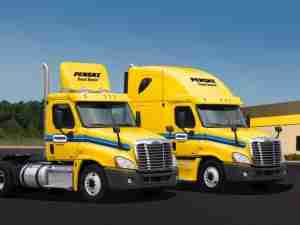Truck Stop Doesn’t Mean Economy Is Headed for a Crash: Gadfly
By: | Feb 08 2016 at 07:41 AM | Intermodal
Does a slump in truck orders mean the U.S. is skidding toward recession? Some context shows us why that might not be the case.
There’s no doubt the recent trend in North American truck orders has been worrying. Class 8 (heavy trucks) orders plunged 48 percent in January year-on-year, according to FTR Transportation Intelligence.
But it’s important to remember 2014 was the strongest year for freight since the recession, according to Bloomberg Intelligence. Truck orders surged in the final months of 2014 to near peak levels, continuing into early 2015, so some kind of correction was inevitable.
There was a similar slump in 2012 but equity investors who interpreted that as a sell-signal will have regretted it. So it’s a little soon to conclude the industry (and the U.S. economy) is headed towards a cliff.
Some buying restraint is understandable given the uncertain global economic outlook. Forecasts vary, but truckmakers typically expect the North American heavy-truck market will drop about 15 percent in 2016. Manufacturers have responded by cutting jobs and production to prevent a further build-up in inventories.
As my colleague Mark Gilbert noted recently, Volvo’s European order book fell more than 99 percent between the third quarters of 2007 and 2008. In comparison, a 15 percent contraction hardly seems to point to economic Armageddon. It also suggests that truckmakers don’t think the recent sharp declines in monthly orders will be sustained over the whole of 2016, unless their forecasts prove wildly off the mark.
Speaking last week, Daimler’s truck chief Wolfgang Bernhard was clear: “We don’t see the sky falling for 2016 in the U.S. but we see a moderate decline from very, very, very high levels that we’ve seen last year.” He expects profits at Daimler’s truck unit—owner of Freightliner—to remain flat in 2016, which would be an achievement in the circumstances.
He’s not alone in urging perspective. Volvo expects the North America heavy truck market to shrink to about 260,000 units in 2016, but that’s still higher than 2013. U.S.-based Paccar said last month that 2016 was on track to be the second- or third-best year in a decade for Class 8 sales. Meanwhile, Volkswagen’s truck boss Andreas Renschler told Bloomberg News Monday that it might expand in the U.S.—hardly a bearish signal.
Stephen Volkmann, analyst at Jefferies, forsees a “mid-cycle” pause in North America in 2016 before the truck cycle accelerates again into 2017 because of an expected capacity crunch caused by tighter safety regulations. Paccar and Navistar shares have bounced in recent weeks, suggesting some investors agree.
And there are other reasons for shareholders to keep on trucking. In spite of near-panic in financial markets, the U.S. economy is expected to expand 2.4 percent in 2016. Low diesel prices should support profit at the freight operators who buy trucks. Indeed, truck tonnage expanded month-on-month in December, according to an American Trucking Associations’ index, a fraction short of its January 2015 record.
Nor is the U.S. truck market a proxy for the global economy. Latin America is horrible: Daimler’s truck sales plunged 35 percent there last year. But both Volvo and Daimler remain fairly optimistic about Europe, where the market is expected to expand slightly this year.
Hopeful truckmakers could yet end up looking like they’ve been inhaling diesel fumes if contagion from China leads the U.S. economy to falter further. But despite first appearances, this is one real economy indicator that may not support the prevailing market gloom.
This column does not necessarily reflect the opinion of Bloomberg LP and its owners.









